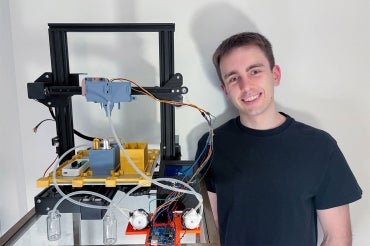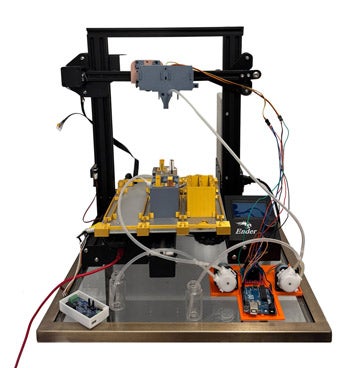With AI and robotics, U of T students build 'self-driving' lab for less than $500

Kyrylo Kalashnikov poses with the robotic system he designed to help make research using self-driving labs more accessible (photo by Kyrylo Kalashnikov)
Published: July 3, 2025
A new system designed and built by undergraduate students at the University of Toronto could help lower the barriers to conducting game-changing research using “self-driving” labs.
These high-tech, automated systems combine artificial intelligence and advanced robotics to dramatically speed up discoveries in fields such as chemistry and materials science.
However, access to such systems is currently limited due to their high cost.
“As these million-dollar tools spin up, we run the risk of freezing out those who want to participate in the scientific process, but who aren’t fortunate enough to be at a top-tier research institution,” says Jason Hattrick-Simpers, a professor in U of T’s department of materials science and engineering in the Faculty of Applied Science & Engineering, who supervised the project.
“Our focus was: Can we create a self-driving lab that is affordable and could be distributed to as many individuals as possible, so that we can ensure equity in science?”
Recent mechanical engineering graduate Kyrylo Kalashnikov began working on the project in the summer after his first year. He continued developing it throughout his entire undergraduate degree and was later joined by fellow student Robert Hou.
“The first iteration was actually built out of Lego,” Kalashnikov says.
“Obviously we had to move on from that for the next three iterations, but we kept the idea of making it modular, with components that can be swapped in or out depending on what you are trying to do.”

Self-driving labs automate and accelerate the process of scientific discovery by screening large numbers of materials to identify those best suited for a given task.
They rely on computer models and algorithms to virtually crawl through huge libraries of known or hypothetical materials, identifying those most likely to have the desired properties.
The top candidates are then synthesized and tested in real life – not by hand, but by sophisticated robotic systems that operate around the clock. The results of these high-throughput tests are then fed back into the model for another iteration, gradually converging on an optimal solution.
Self-driving labs are central to the mission of the Acceleration Consortium, an institutional strategic initiative at U of T that brings together a global community dedicated to accelerating scientific discovery through AI and automation. In fact, it was an innovation from one of the consortium’s labs that inspired the student project.
“Our focus with this system was on electrochemistry, which is relevant for designing things like new materials that can resist corrosion or new electrolytes for batteries or fuel cells,” says Hattrick-Simpers, who is a member of the Acceleration Consortium’s scientific leadership team.
“One of the most expensive components of a system like that is a tool called a potentiostat, which can cost tens of thousands of dollars just by itself. But Professor Alán Aspuru-Guzik and his team at the Acceleration Consortium have designed an innovative, low-cost potentiostat, which we were then able to use in our version.”
The rest of the system designed by the students was built from off-the-shelf parts; Kalashnikov estimates the total cost as less than $500. The setup repurposes a consumer 3D printer gantry, adds aquarium-grade pumps for liquid handling, a dual-servo gripper for electrode transfer and a handful of 3D-printed brackets and baths.
All of these components are controlled by custom, open-source software. The software, along with the computer-aided design files, electrical schematics and firmware is freely available on GitHub.
“The target audience for something like this is people who are really excited to get into science and engineering, but who don’t have access to expensive tools,” says Kalashnikov.
“That basically describes me in high school. I remember trying to build my own self-driving car and finding a lot of what I needed in open-source repositories online. It was the only way for me to learn because I didn’t know anyone else could teach me.
“Throughout the three years of this project, I just kept thinking that there was somebody else like me out there who might want to learn and build these cool things, and who would benefit from this project. Now, they can do that.”
Hattrick-Simpers is integrating the new system into a course he teaches on advanced AI for self-driving labs. But he’s also hoping others take the idea and run with it.
“There is a potential that if we can have a couple of these tools floating around in the world, we could create even little ‘internet of scientific things’ around them,” he says.
“Having these distributed tools and their users interact with one another can help build up a really robust community around self-driving labs, which in turn will drive forward scientific innovation.”



